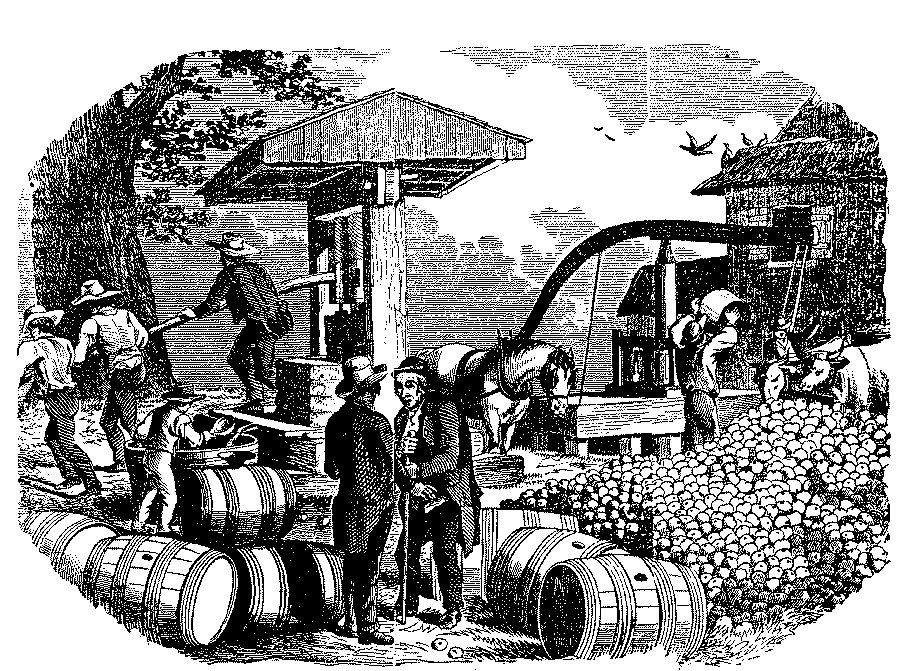![]()
![]()
![]()
Cider is made from apple juice which has undergone two different kinds of
fermentation. The first fermentation is carried out by yeasts which have
either been added deliberately or which are naturally present on the apple
skins. The second fermentation is carried out by lactic
acid bacteria which are present in the apple juice and also in the area in
which the fermentation is carried out. The secomd fermentation can occur
concurrently with the yeast fermentation but more often it is delayed until
the fully fermented cider reaches the right temperature, normally in the
late spring or early summer of the year following that in which the cider
was made.
The second fermentation is carried out by lactic
acid bacteria which are present in the apple juice and also in the area in
which the fermentation is carried out. The secomd fermentation can occur
concurrently with the yeast fermentation but more often it is delayed until
the fully fermented cider reaches the right temperature, normally in the
late spring or early summer of the year following that in which the cider
was made.
Traditional cider making starts with the picking of the apples. These are left to mature for a week and then tipped into a "scratcher" which crushes the apples. In more modern plants the apples are reduced to a pulp in a grater type mill. The apple pulp is known as the pomace or pommy.
Next the pulp must be crushed to extract the juice. This is done in a cider press (seen to your left). Several types of press are used. The traditional type is a rack and cloth press (sometimes known as a pack press). In this type of press a sheet of sisal or hessian is placed across the bottom of a square frame above a trough. A layer of pomace, 4-5 inches deep, is poured onto the hessian. The hessian is folded over the pomace, completely enclosing it. Another sheet of hessian is placed on top of the first and the process repeated until the layers fill the frame. The cider press is then racked down onto the layers and the juice runs into the trough. The pomace is pressed until it is solid and no more juice runs out. The press is then racked up, the layers of pomace are broken up by hand, and the whole lot is re-pressed. The pressed pomace is dried and used for cattle feed. Traditional cider is often served completely flat and may be cloudy. It may also be served a naturally-conditioned cask cider, analagous to real ale.
Scrumpy is a term often used to described certain types of cider. It is one of those terms for which everyone has a definition and everyone's definition is different. Originally it was cider made from windfalls (scrumps). For most people it means a rough, cloudy and unsophisticated cider. It is most often applied to young cider, cider that is only a few months old and has yet to undergo the maturation phase. For other people, including some cider makers, it can mean the finest cider, from selected, better apples, slowly fermented and matured for longer than ordinary ciders.
When is it a cider and when an apple wine? This is a frequently asked question. There is no definitive answer to this. The best that can be said is that first of all apple wine falls outside of the definitions given above. Secondly, apple wine will almost always be made with dessert (sweet) apples. This materially affects the flavor of the finished drink. Cider apples contain high levels of tannins and significant amounts of malic acid. These are not found to significant levels in dessert apples. Therefore a cider has a sharpness (due to malic acid) and a bitterness (due to tannins) which is simply not found in apple wines. Commonly people will refer to the qualities that these components give to the cider as the "bite". This is not apparent in apple wine. The final distinction is the alcohol content. Cider generally has an alcohol content which does not exceed (about) 8 percent by volume. Apple wines can commonly have higher alcohol contents. These wines will inevitably have been fermented using wine yeasts, not natural or ale yeasts, since only wine yeasts are tolerant to the high alcohol levels. The wine yeasts will impart their own flavour profile to the apple wine, moving it further away from a true cider.